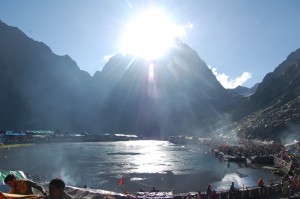According to history facts, it is believed that Lord Shiva created Manimahesh after he married Goddess Parvati (who is worshipped as Mata Girja, Gori). There are many legends narrated linking Lord Shiva and his show of displeasure through acts of avalanches and blizzards that occur in the region.
Legend also mentions that Shiva performed penance on the banks of Manimahesh Lake. It is also mentioned that Gaddis – the tribes of this region (the people who reside in the Gaddi Valley which is the name of the upper regions of Ravi River where the Mount Chamba Kailash lies) adopted Lord Shiva as their deity. Further, according to the legend, the Shiva, gifted the Gaddis with a Chuhali topi (pointed cap), which they wear traditionally along with their other dress of chola (coat) and dora (a long black cord about 10 – 15 m long). The Gaddis started calling the land of this mountainous region as Shiv Bhumi (Land of Shiva / Abode of Shiva) and themselves as devotees of Shiva.
The legend further states that Shiva married Parvati at Mansarovar Lake and became the Universal parents of the universe, Shiva created the Mount Kailash in Himachal Pradesh and made it his abode. He made Gaddis his devotees.
Manimahesh was also considered the abode of the three Lords of the universe namely – Shiva, Vishnu and Brahma. Manimahesh was considered as the heaven of Lord Shiva. It is Believed that the waterfall seen at the Dhanchoo on the way toManimahesh Lake, emanates from the lake from Vishnuloka or Vaikuntha dham of Vishnu. The heaven of Brahma is cited as a mound overlooking the Bharmaur City.
The Gaddis also believe that Shiva resides here in the Mount Kailash here for six months, where after the Lord Shiva moves to the Netherworld (PatalLok) handing over the reigns to Lord Vishnu. Shivalives here from start of Spring Season to end of Rainy Season and departs from here from Autumn. The day Lord Shiva departs to the netherworld is observed by the Gaddis reverentially every year on Janamashtami. Shiva returns from the Netherworld to Bharmour at the end of February, before the night of his wedding and this day is observed as the Mahashivratri day. Gaddis observe this also as a festive day since Shiva and Parvati returned to Mount Kailash in the Gaddi land.
Derivation of Manimahesh signifies a “Jewel (Mani) on Lord Shiva’s (who is well known as Mahesh) crown“. According to a local legend, the moon-rays reflected from the jewel can be seen from Manimahesh Lakeon clear full night (which is a rare occasion). However, it has been inferred that such a phenomenon could be the result of reflection of light from the glacier that embellishes(अलंकृत) the peak in the form of aserpent around Shiva’s neck. Infact, the light reflected from the glacier that adorns the peak really looks like a Shiny Jewel on the head of the mountain.
A rock formation in the form of a Shivling on this mountain is considered as the manifestation of Lord Shiva. The snow field at the base of the mountain is called by the local people as Shiva’s Chaugan (Play Field).
A legend in which Lord Shiva himself is tricked is narrated. According to this narration linked to Dhanchoo where pilgrims spend a night on their way to Manimahesh Lake. Lord Shiva pleased with the devotion of one his ardent devotee Bhasmasur (a demon) bestowed a boon, which gave powers to Bhasmasur under which Bhasmasurtouching any one would reduce that person in to ashes. Bhasmasur wanted to try this boon on Shiva himself. He, therefore, followed Shiva to touch him and get rid of him. However, Shiva managed to escape and enter into the waterfall at Dhanchoo and take shelter in a cave behind the rolling waters of the fall. Bhasmasura could not cross the waterfall and Vishnu impressing him with his Mohini rupa (impressive damsel form) killed Bhasmasura near Dhanchoo Waterfall. Since then the fall is considered holy.
A rare event of the first sun rays falling on the Mani Mahesh Kailash peak is seen as reflection in the lake like saffron tilak. This display in the lake has enhanced the legendary belief of the Gaddis on the sanctity of Manimahesh Lake at the base of the Mount Kailash, which they visit on an annual pilgrimage. This event has also contributed to the practice of taking bath in the lake on Janamashtami or Radhashtami.

